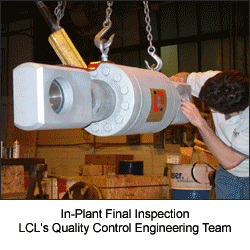| |
|
|
|
|
|
|
|
|
|
 |
 |
 |
 |
 |
|
|
|||
 |
|||||||||
 |
|||||||||
 |
Earthquakes in California, USA
and Kobe, Japan have recently demonstrated the potential for very
large seismic events that hitherto were not forecast. The levels of
disturbance experienced during these powerful earthquakes were far
greater than structural designers, and their associated design codes,
had forecast; the result was wide spread damage and destruction to
highways and bridges as well as loss of life.
One important lesson that has been learned is that it is imperative that bridges, which connect major transportation routes, must continue to function after an earthquake or geological disturbance. New technologies and design efforts at LCL have resulted in a system of Shock Transmission and Damping Units, or STUs and SDUs for short, that can now contribute towards the ability for large structures to better withstand such large disturbances. The advantage of LCL's STUs and SDUs is that they can be integrated with new and existing structures without interfering with that structure's normal load bearing and connecting systems. In so doing they can allow for slow moving structural deflections (expansion, contraction and rotation) due to thermal effects, creep, wind and traffic. But during high dynamic loading, as the result of an earthquake, explosion or other event, the combination of the rigid connection created by STU and the damping effect of the SDU allows the structure to withstand such high dynamic loads. LCL's STU and SDU systems lead the industry because of the ease in which existing structures can be upgraded in the most cost effective way; for example road traffic does not need to be stopped during bridge installations and the time to install is very short. Furthermore LCL's devices are designed to have a usable life of 100 years and are maintenance free, easily inspected and extremely easy to be replaced. Independent Laboratory testing has certified LCL's STU and SDU devices for a wide range of static and dynamic loads and displacements, as well as operating temperatures down to -35 degrees Centigrade.
|
10th Congress on the advancement of
Research in Quebec for Bridges
|
|
||||||
| |
|||||||||
